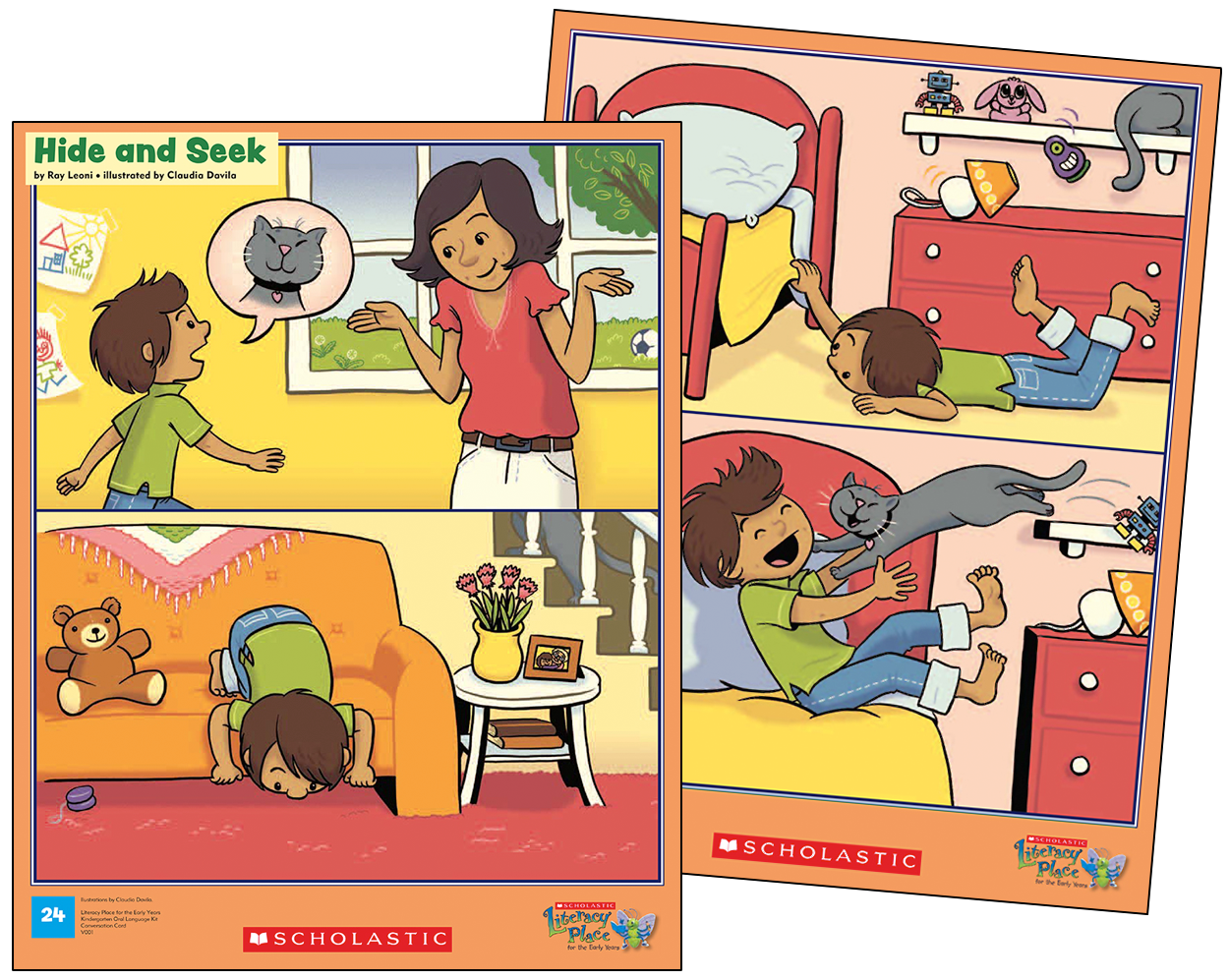Oral Language Teaching Strategy:
Extend and Check the Meaning Expand on the language and details in students’ communication to check the meaning.
Time: one 30-minute lesson or two 15-minute lessons
Materials: Comic Strip Cards #24-25
Grouping: whole class or small group
Assessment:
Kindergarten Oral Language Assessment Scale
FOCUSING ON THE PICTURE
Teaching Tip: Before introducing these cards, you may want to introduce students to a comic book or a comic strip. Magazines such as Chirp, and Chickadee have comics in them. These magazines may be found in your school or local library.
[Analyzing/inferring]-
Let’s place these labels on the cards to help us remember the order the pictures occur in. Now, I want you to look closely at the comic. What do you see in the pictures? What do you think is happening?
Show students the cards and give them time to really analyze the pictures. Have two sticky notes labelled ‘first’ and ‘second.’ With the students, place the sticky notes on the cards in the correct order.
- After the students have had an opportunity to really look at the pictures, have them turn to the person they are sitting beside and share their ideas with their partner.
- Provide time for partner discussion and then invite a few partners to share their thinking with the group. Remember to extend and check meaning if required.
- Build on what students have to say, offering prompts to stimulate discussion:
- Who do you think the people in these pictures are?
- Why do you think there is a cat inside a speech bubble?
- Where do you think they are?
- What is happening in each picture?
- What clues can we use to figure out what is happening in these pictures?
- What story do you think is being told?
Cara: Cat has heart.
Teacher: Do you mean the cat with a heart collar around his neck?
GOING DEEPER
[Inferring/evaluating]- Offer open-ended prompts that focus the students on the emotions portrayed in the picture.
- Let’s take a closer look at the first picture in this comic. What is the boy saying to his mom in the first picture? How do you know? What is the mom saying to the boy? Look closely at her arms.
- Now let’s take a closer look at the second picture. What is the boy doing? Why do you think he is looking under the couch?
- Where can you find the cat? Is the cat under or above the boy?
- Let’s look at the third picture. What is the boy doing now? Where can you find the cat in the picture? Do you think the cat is hiding from the boy?
- What is happening in the last picture? What game do you think the boy and his cat were playing? How do you think they are feeling in the last picture? Why do you think this?
You may conclude the lesson at this point and do the second part on the next day, or you may decide to continue and do Connecting and Predicting as part of the first lesson.
CONNECTING
Teaching Tip: If you decide to do Connecting and Predicting on the second day, begin your lesson by reviewing the pictures with the students.
[Making connections]- Have students draw on their personal experiences to make connections to the boy in these pictures.
- Think of a time when you tried to find something. What did you do?
- Do you or does someone you know have a pet? Do you play games with a pet? How does the pet make you feel?
- What game might the boy and cat be playing in the picture?
- How do you feel when you play hide and seek? Who do you usually play with?
- Do you think cats like to hide? Where do they hide?
Antonio: My cat hide under my house.
Teacher: Are you saying Antonio that your cat likes to hide under things in your home, like under a table or a bed?
PREDICTING
[Predicting]- Ask students to think about where the cat was or what the cat was doing in the first picture.
What do you think will happen next? What makes you think this?
- Ask students to think about what might happen after the last picture.
LESSON EXTENSIONS
-
Ask students what they think the cat is thinking as the boy tries to find him. Using the cat puppet as a prop, have students create dialogue for the cat for each picture.
-
Provide each set of partners with one or two thinking bubbles to write on. Have the partners create thinking bubbles for one picture, for the boy or the cat.
-
Introduce prepositions that describe a place (under, over, up, down, above) to the students. Play a game with students to actively explore these words. For example, use a skipping rope and have students go under it, over it, hold it up, and put it down.
FOLLOW-UP IN CENTRES
-
Invite students to use the puppets at the drama centre to retell the story.
-
Cut out a felt cat and boy for students to use when reenacting the comic at the flannel board.
-
Provide paper divided into four squares at the art centre where students can create their own comic.

